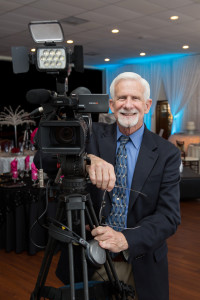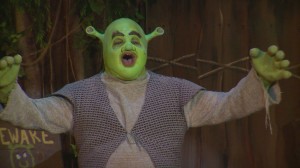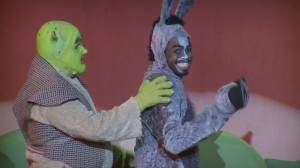
When it comes to recording live performances in L.A. whether it’s theater, ballet, concerts or recitals, the same considerations apply as with any other genre of videography: Focusing, following, framing and exposing. What’s different in this type of work, and more challenging, are the ever-changing recording conditions on stage that require a very high level of proficiency behind the camera.
The risk factor: Few things are technically more challenging than trying to maintain a close-up of a performer moving across a stage. Close-ups of moving subjects run the risk of falling off target and creating a distraction in the finished product. The more zoomed-in and the faster the movement of the subject, the greater the risk of miscalculating the shot, particularly if the subject takes a sudden jog to the right or left, or suddenly stops as frequently happens on stage. Whether or not this type of shot comes off correctly depends on the skill and the equipment of the videographer. Much less risky (but not nearly as much fun) is to compose a wider shot, or to use a second camera locked down with a medium-to-wide safety shot as a backup so that a poorly executed close-up isn’t the only shot available. Finally, another way to reduce the risks associated with close-up videography is to attend a full dress rehearsal to become more familiar with the show. This may give the videographer a head’s up as to what’s in store, but it doesn’t help much with lack of experience and poor technique.
Pushing the limits: In my own opinion, as a videographer who records live performances throughout the Los Angeles and Orange County area each year, there’s little satisfaction in playing it safe using nothing but wide shots for an entire show (unless directed to do so). The joy of recording live shows is in finessing the more difficult shots, pushing the limits of one’s talent for the greater production value of the recording. Why risk it? Because good close-up technique (in conjunction with medium and wide shots) makes for a better viewing experience, more like being at the live performance itself. What it comes down to is this: Recording live performances requires a high level of technical skill, sharp powers of observation, an eagle’s eye for detail, a steady hand and a lot of experience with this specific type of videography in order to produce exceptional results in an environment that’s constantly changing. (See the short demo clip below).

An interesting aside: If you ever have the chance to closely observe a skilled videographer in action, it’s an amazingly well-orchestrated performance in and of itself…one finger on the iris, another on the focus ring, one eye on the monitor, the other eye on the stage, earphones monitoring audio, one hand on the tripod and the zoom control.
A 6th sense: To consistently pull-off a well-followed close-up, the videographer has to be able to sense where the performer is headed ahead of time in order to remain perfectly in sync for the duration of the shot. The trick is to sense it slightly ahead of the action instead of reacting to it. In the latter case the performer is more likely to fall out of frame. This type of work is challenging for novices and experts alike; it takes a very intense level of concentration as well as seamless hand-to-eye coordination. It’s definitely not a situation where the videographer can afford a lapse in focus during the show. Performance videography, much like wedding videography, has no forgiveness for lapses. There are no re-do’s. (I have to admit as a dancer-turned-videographer, I have an advantage in anticipating a performer’s movement on stage, having been there myself, so, following the action close up feels very natural).
Clunky equipment: You just can’t expect a clunky tripod to afford the videographer the kind of smooth camera control I’m referring to. Finessing close-ups is dependent upon the fluidity of the tripod head and its ability to smoothly overcome the inertia of beginning to pan to the right or left without a noticeable ‘bump’ at the start of the pan. Because the camera may be in constant motion during a show, a videographer using the wrong kind of tripod is going to be fighting that tripod for the whole performance and the recording will show it.
The right lens: Because camera location can wind up at the far back of the theater, I use a 2X extender lens to get the kind of close-ups I’ve been mentioning. Mine is made by Century Optics, a very heavy piece of glass that fits over the fixed camera lens of my Sony PMW EX-1R, but high in quality, with no image distortion. The only caveat is that once it’s on the camera, it’s only good for close-ups. Zooming back even 20% causes a vignette which can’t be used in the finished product. In other words, you pretty much have to stay on close-ups for the whole show, or try to find a time to remove the extender lens. I record performances with 3 cameras, a wide, locked-down safety shot, a medium shot and the close up with the extender lens, so no change in lenses is necessary.

A suggestion: If you’re planning to have a live performance recorded professionally, particularly if you’re intending to sell copies of the show (which should have a professional look to them), plan ahead to hire a videographer skilled in this demanding genre of videography. You’ll be amply rewarded with outstanding results.
(I’ve just finished recording and editing a run of productions: “Shrek The Musical”, “Oliver” and “Hairspray” for Encore Entertainers, an outstanding theater production company out of Redondo Beach, California, and the ballet “Coppelia” for Peninsula School of Performing Arts (www.pspadance.com; (31)0 375-1398) at the Norris Theater in Palos Verdes). Here’s a short highlight from “Coppelia”.
More videos can be seen in our video gallery. Enjoy!






